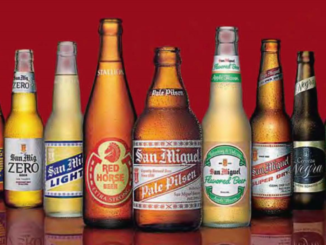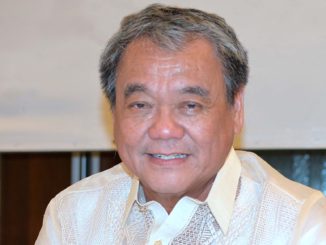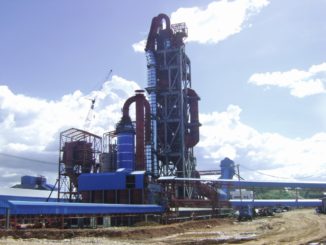
The youngest member of the Cabinet, Mark Aguilar Villar, 39, is President Duterte’s infrastructure czar.
He comes to the job with ample credentials. He is the son of former House Speaker and former Senate President Manuel B. Villar, a self-made billionaire with estimated wealth of over $2 billion. His mother is incumbent Senator Cynthia Villar.
Mark was first elected to public office in 2010 as congressman of the lone district of Las Piñas, succeeding his mother, Cynthia Villar, who served for three terms before becoming senator.
As congressman, Mark served as chairman of the House Committee on Trade and Industry, and vice chairman of the House Committees on Overseas Workers Affairs, Labor and Employment, and Science and Technology.
As a member of the 15th and 16th Congress, young Villar authored several bills on education, health and livelihood, including the Negosyo Act promoting micro finance and the Lemon Law protecting buyers of motor vehicles. He was also one of the proponents of the Co-Loading Act which opened domestic transport and shipping to foreign vessels.
Villar ran for a third term in the 2016 elections and won. He joined Duterte’s Cabinet on Aug. 1, 2016.
He is married to fellow lawmaker, DIWA Party-list Representative Emmeline Yan Aglipay. They have a daughter, Emma Therese.
As secretary of the Department of Public Works and Highways, Mark Villar presides over the largest infrastructure spending by government in history—both in value per year, and in combined spending in six years.
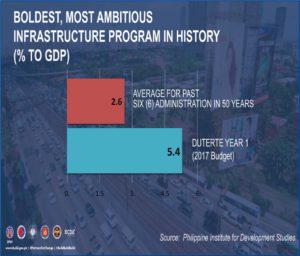 The massive modernization program has already accounted for 5.4% of the Gross Domestic Product (GDP), the value of total goods and services produced by the economy, in 2017. The 5.4% is double the 2.6% of GDP average infra spending of the six administrations in 50 years before Duterte.
The massive modernization program has already accounted for 5.4% of the Gross Domestic Product (GDP), the value of total goods and services produced by the economy, in 2017. The 5.4% is double the 2.6% of GDP average infra spending of the six administrations in 50 years before Duterte.
In six years, Budget Secretary Benjamin Diokno estimates the Duterte administration will spend P8 trillion to P9 trillion ($160 billion to $180 billion) in public infrastructure to make up for the government’s underinvestment in roads, railways, airports, seaports, and other infrastructure facilities.
Poor infra poor economy
From 1983 to 2006, infrastructure and capital spending amounted to a mere 1.1% to 1.5% of GDP.
Analysts and academicians have long cited the country’s poor and crumbling infrastructure as a constraint to growth and investments. “Poor infrastructure hampers economic productivity, trade mobility, and the accessibility of public services,” says Diokno.
Poor infrastructure has pulled down the Philippines’ overall competitiveness. The country lags behind its ASEAN-5 peers in terms of the quality of its overall infrastructure. “What is worrisome is that the Philippines’ overall infrastructure rank has steeply declined from 94th in 2009 to 112th,” Diokno points out.
In 2017, the first full year of the Duterte administration, infra spending was a record P450 billion. That enabled the government to escape the bane of post-election growth—a sharp decline. The economy grew by 6.7% in 2017.
Economic growth slowed to 4.8% in 2005 from 6.7% in 2004, an election year. Growth fell to 3.7% in 2011, from 7.6% in 2010, an election year.
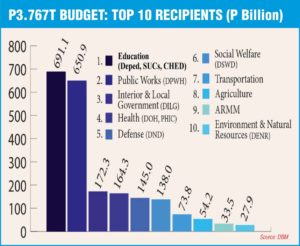 So huge infra spending works magic. This 2018, the DPWH budget is a whopping P650.9 billion, up P193.3 billion or 43% over 2017. The P650.9 billion is only the DPWH portion of total spending for infra. Including other projects outside the DPWH ambit, such as those under the Department of Transportation (2018 budget: P73.8 billion), total infra spending under Duterte’s “Build, Build, Build” will reach P1.097 trillion this year—6.3% of GDP.
So huge infra spending works magic. This 2018, the DPWH budget is a whopping P650.9 billion, up P193.3 billion or 43% over 2017. The P650.9 billion is only the DPWH portion of total spending for infra. Including other projects outside the DPWH ambit, such as those under the Department of Transportation (2018 budget: P73.8 billion), total infra spending under Duterte’s “Build, Build, Build” will reach P1.097 trillion this year—6.3% of GDP.
The other projects:
Roads, school buildings and flood control systems
- P431.1 billion = construction of roads and bridges
- P92.4 billion = school buildings
- P95.6 billion = flood control systems
- P48 billion = right-of-way acquisitions
Rail transport program = P26 billion
- P6.6 billion for Mindanao Railway Project Phase I
- P7.1 billion for North-South Railway Project Phase II, PNR South
- P1.3 billion for LRT Line I South Extension (Cavite) Project
- P4.8 billion for MRT-III subsidy
Aviation infrastructure program = P10.1 billion
Ports and harbors development and modernization = P1.7 billion
PAMANA (Office of the Presidential Adviser on the Peace Process) P8.5 billion for development interventions in the form of road and bridge construction, free tertiary education, livelihood opportunities, welfare assistance and health insurance coverage
“We have just completed the plans for the projects,” says the Wharton-educated Villar. “Implementation will readily ramp up in 2018,” he vows.
“As a result, you will see our economic indicators rising as well,” he enthuses.
“The projects are actually investments,” Villar points out. As investments, they will yield an internal rate of return (IRR) of not less than 10% for exceeding the 2012 inflation rate of 3.2%. In fact, most of the projects have an IRR of 15%.
“These investments will drive up economic growth,” explains Villar. He thinks growth of 7.5%-8% per year very do-able.
The DPWH’s P650.9 billion budget will create additional one million jobs a year or 2,740 jobs a day. That will make Mark the country’s biggest job generator.
“You will see the employment rising,” gushes Villar. And poverty incidence declining.
Duterte hopes to reduce poverty to 14% by the end of his term in 2022.

